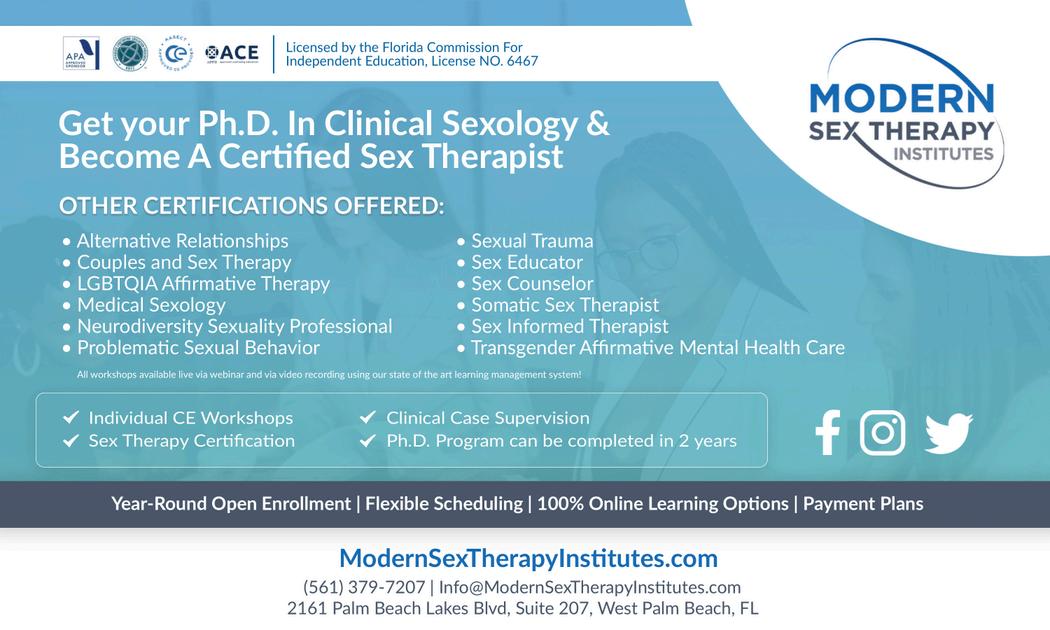








To borrow a movie phrase... “and just like that” the New Year is here.
January is the month of reflection for many people, but for me, it started in December as the prior year was slipping away. As the opening of my Mama’s favorite soap opera poignantly said: “Like sands through the hourglass, so are the days of our lives ” An hourglass is quite a visual image of how time passes continuously and without interruption How has 2024 passed for you with your practice or your education? What are you bringing into this New Year from last year’s experiences? Ask yourself the question you ask Clients: “Are you ready to deal with any “unfinished business”?
One option to encourage you on hectic, full appointment days or research paper deadlines is to make your own Gratitude List.
Write the names of people, places and things that you look forward to continuing to have in your life during this New Year On those days when you feel the weight of this work more heavily than usual, look at your Gratitude List Remember to add why you chose this work or this graduate degree Be specific about what it means to you to help people who are in crisis, despair, depression or uncertainty. When your eyes cross at the end of the day and you want to just finish reviewing one more case study, remember why it matters to train the next generation for our profession or to listen attentively to one more client’s story.
Respectfully,
Dr. Kathie Erwin, FMHCA President





Page 39
Thinking Like a Business Owner: A philosophy and Business Plan for Survivors of Family of
Page 44
Submit for the next issue of InSession Magazine!

InSession Magazine is created and published quarterly by The Florida Mental Health Counselors Association (FMHCA)
FMHCA is a 501(c)(3) non for profit organization and chapter of the American Mental Health Counselors Association.
FMHCA is the only organization in the state of Florida that works exclusively towards meeting the needs of Licensed Mental Health Counselors in each season of their profession through intentional and strengthbased advocacy, networking, accessible professional development, and legislative efforts.
Let your voice be heard by becoming a FMHCA Member today!
Click here to view FMHCA's current Bylaws.
CONTRIBUTE:
If you would like to write for InSession magazine or purchase Ad space in the next publication, please email: Naomi Rodriguez at naomi@flmhca org
THE INSESSION TEAM:
Naomi Rodriguez- Editor
Victoria Siegel, LMHC- Expert Advisor
There shall be no discrimination against any individual on the basis of ethic group, race, religion, gender, sexual orientation, age, or disability
DISCLAIMER: Information in InSession Magazine does not represent an official FMHCA policy or position and the acceptance of advertising does not constitute endorsement or approval by FMHCA of any advertised service or product. InSession is crafted based on article submissions received. Articles are categorized between Professional Experience Articles & Professional Resource Articles.
Professional Experience Articles are writer's firstperson pieces about a topic related to their experience as a mental health professional, or an opinion about a trend in the mental health counseling field
Professional Resource Articles are in-depth pieces intended to provide insight for the author's clinical colleagues on how to be more effective with a particular type of client or a client with a particular disorder, or tips for running their practice more efficiently
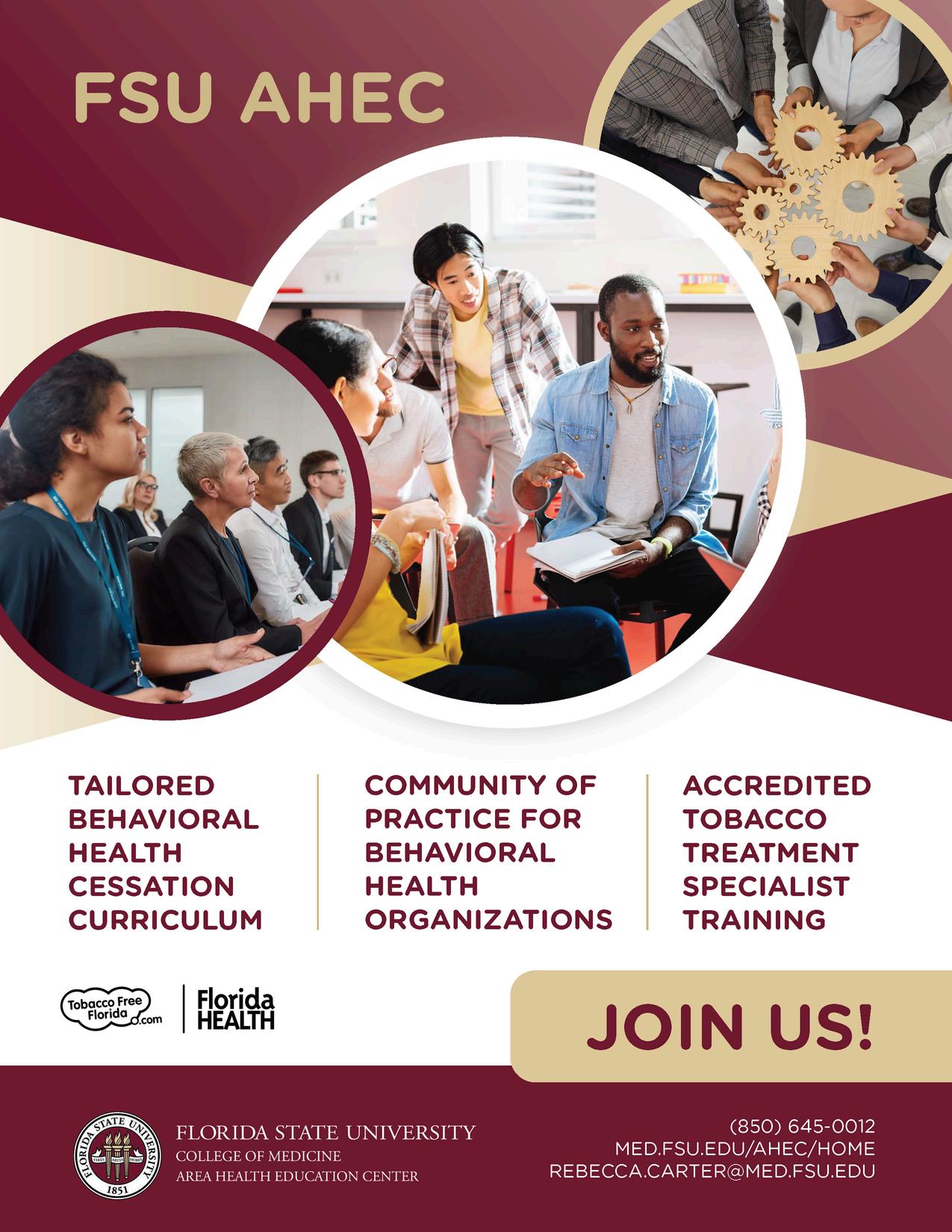
The Florida Mental Health Counselors Association (FMHCA) is the State Chapter of the American Mental Health Counselors Association (AMHCA) FMHCA is the only organization dedicated exclusively to meeting the professional needs of Florida’s Licensed Mental Health Counselors
The mission of the FMHCA is to advance the profession of clinical mental health counseling through intentional and strengthbased advocacy, networking, professional development, legislative efforts, public education, and the promotion of positive mental health for our communities
Its sole purpose is to promote the profession of mental health counseling and the needs of our members as well as:
Provide a system for the exchange of professional information among mental health counselors through newsletters, journals or other scientific, educational and/or professional materials
Provide professional development programs for mental health counselors to update and enhance clinical competencies
Promote legislation that recognizes and advances the profession of mental health counseling
Provide a public forum for mental health counselors to advocate for the social and emotional welfare of clients
Promote positive relations with mental health counselors and other mental health practitioners in all work settings to enhance the profession of mental health counseling
Contribute to the establishment and maintenance of minimum training standards for mental health counselors
Promote scientific research and inquiry into mental health concerns
Provide liaison on the state level with other professional organizations to promote the advancement of the mental health profession
Provide the public with information concerning the competencies and professional services of mental health counselors
Promote equitable licensure standards for mental health counselors through the state legislature





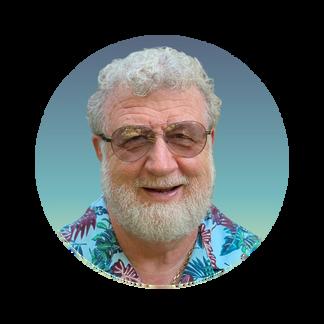

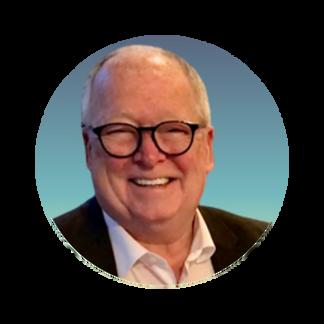








Therapists are often seen as dedicated professionals who spend their days helping others navigate the complexities of life. But beyond the well-understood attributes of patience, empathy, and dedication, what truly fuels therapists? What brings them joy in their demanding yet deeply fulfilling work? Here’s a look at what therapists genuinely love about their profession.
At the core of every therapist's passion is the profound human connection Therapists love the deep and meaningful relationships they build with their clients The process of being trusted with another person’s story their fears, hopes, and dreams is an honor that most therapists don’t take lightly. This unique bond allows therapists to witness the transformation and growth of their clients, which is both humbling and rewarding.
There is nothing quite like witnessing a moment of breakthrough during a session Whether it’s a client’s realization of a deeply rooted belief or an emotional release that
brings clarity, these moments remind therapists why they chose this path. The knowledge that they played a part in guiding someone to greater self-understanding or healing brings immense satisfaction.
Therapists often have an insatiable curiosity and a love for learning Every client and every session presents a new challenge or a unique story, ensuring that no two days are ever the same Therapists love that their profession requires them to be constant learners, staying up-to-date with new research, therapies, and practices Whether it's attending workshops, reading the latest studies, or obtaining additional certifications, therapists are committed to growing for the benefit of their clients.
Many therapists find great joy in being advocates for mental health awareness and education The opportunity to break down stigmas, educate communities, and foster open conversations about mental health is a passion shared by many
in the field
Therapists love to see their efforts ripple beyond the therapy room, contributing to a society that values mental wellbeing
Therapists appreciate the freedom to use creativity in their practice. Whether through art therapy, play therapy, roleplaying techniques, or integrating mindfulness and movement into sessions, therapists love exploring different ways to connect with clients and facilitate healing This creative flexibility not only keeps the job engaging but also enhances the therapeutic experience for clients
Celebrating
Progress in therapy isn’t always monumental, and therapists cherish the ability to celebrate every step forward. Whether it’s a client finding the courage to set boundaries, practicing selfcompassion, or managing a tough situation without old, harmful coping strategies, these wins are sources of joy. Therapists love the moments when they can say, “Look how far you’ve come,” and see their clients recognize their own growth
Above all, therapists love the deep sense of purpose their work provides. Knowing that they are making a tangible difference in people's lives helping them navigate trauma, rebuild selfworth, or find peace is a powerful motivator. Therapists are often driven by a calling to help others, and that sense of purpose enriches their day-to-day work, even when it’s challenging.
The Supportive Community
Therapists love being part of a community of professionals who share similar values and goals. Being surrounded by colleagues who understand the unique challenges of the profession fosters an environment of support and growth. Professional associations like the Florida Mental Health Counselors Association (FMHCA) offer therapists a network of peers, opportunities for collaboration, and resources that enhance both their personal and professional lives.
Closing
Therapists love what they do because it aligns with their core values: empathy, growth, connection, and a dedication to fostering change. The rewards of the profession go beyond accolades or financial gain; they are found in the moments of connection, learning, and the knowledge that they are making the world a little better, one session at a time. If you’re a therapist reading this, take a moment to reflect on what you love about your work. And if you’re someone considering entering the field, know that while the job is demanding, it’s filled with moments that make the journey
In the midst of giving so much to others, therapists often need a moment to recharge and reconnect with themselves. Here’s a brief mindfulness exercise designed to bring you back to center and nourish your own well-being.
1.
Find a Comfortable Position: Sit or stand in a comfortable position, allowing your shoulders to relax. Close your eyes if that feels right, or simply soften your gaze.
2.
Breathe Deeply: Take a deep breath in through your nose, hold for a count of four, and then exhale slowly through your mouth. Repeat this breathing pattern three times, focusing on the sensation of air filling your lungs and releasing any tension with each exhale.
3. Release Tension: Starting from your head, gently scan down through your body Notice any areas of tension and, as you exhale, imagine releasing that tension Allow your face, neck, shoulders, arms, torso, legs, and feet to soften
Visualize Your Roots: Imagine roots extending from your feet, reaching deep into the earth. Picture them connecting you to the ground, offering stability and support. With each breath, feel yourself becoming more grounded and secure
4 Express Gratitude: In your mind, express gratitude for the opportunity to do work that you love. Recognize the meaningful connections you’ve built, the growth you’ve witnessed, and the lives you’ve touched.
6.
5. Return Slowly: When you’re ready, take a final deep breath, slowly open your eyes, and bring your awareness back to the present moment. Carry this sense of calm and gratitude with you as you move forward.
Taking just a few minutes for mindful grounding can make a world of difference, allowing you to reconnect with the joy and purpose of your work
Written By: Diana Huambachano, LMHC
Diana is a dedicated licensed mental health counselor currently affiliated with a thriving private practice With extensive experience in trauma-informed care, Diana specializes in workin with individuals facing anxiety, depression, and co She is passionate about guiding clients toward emotional resilience and holistic healing, integrating evidence-based approaches with a warm, compassionate touch Diana's clientcentered practice is known for fostering trust, empowerment, and long-term personal growth



In a recent workshop designed to teach therapists how to craft a concierge practice, it was astounding that most participants didn’t recognize their value and worth as clinicians Some therapists had been in practice for decades and hadn’t raised their fees. Others saw patients every hour and described symptoms of burnout fatigue, resentment, procrastination, lack of satisfaction, etc. Most participants said their patients called and texted at will, and they felt obligated to respond without charging for these additional services.
The first reason is some patients want (or need) more but are stuck with a once or twice-weekly therapy model This is particularly painful for a crisis patient who needs intensive work but is not necessarily right for residential treatment Among these patients are those who could afford and would gladly pay for concierge services Second, seeing fewer patients for set fees offers more explicit boundaries with specific, measurable goals within a timeframe. Third, it reduces the factors of burnout, too much investment, and too little return, and concierge therapy has a built-in business model of set fees
Most people think of “concierge” as only referring to medical care. However, these same services are also effective in the mental health field. Having crafted a concierge practice during COVID, I have successfully treated dozens of patients who have excelled in their healing and recovery. This model has better served my clientele and allows me more free time to write, promote my books, mentor, and publicly speak
The therapist can offer various options to design packages that suit their patients’ needs. The treatment plan is weekly or monthly and can be extended depending on the patient’s needs. It might include texting and calls between sessions, additional sessions, intensives, testing, incorporating other skills (yoga, workouts, nutrition, etc.), collaboration with other professionals, or other appropriate services. The fees are set depending on the services and are collected upfront. I have a brochure that outlines the services provided for a minimum of one month that can be upgraded to three, six, nine, or twelve months
Concierge isn’t right for everyone, but for those who want to immerse themselves fully and can afford it, it’s a win-win for patients and therapists. While the thought of concierge psychotherapy raises a few eyebrows, the course I designed to teach it is entirely ethical and is approved for 5 CEUs by the Florida Certification Board.
If you wonder if you ' re worth it, think about this: One of the participants signed up for the course after speaking with a life coach who charged $1500 00 per hour and had made a million dollars in the past year. Most life coaches have basic certification without any guardrails. You have an extensive education, licensing requirements, and training. Your services are of great value. Concierge therapy utilizes your training and gifts to serve your patients best while expanding your business practice. If all of that work is worth as much as a basic coaching certificate, then why not give it a try?
Written By: Dr. Donna Marks, LMHC
Donna is a psychotherapist and an addictions counselor in Palm Beach, Florida She develope an addiction training program at Palm Beach Community College, which has grown into a fou and won the Florida Governor’s Council Award Gestalt therapy, Psychoanalysis, Hypnotherapy, and Sex Therapy She authored Exit the Maze: One Addiction, One Cause, and The Healing Moment: Seven Paths to Turn Messes Into Miracles, available here, She shares her message on podcasts, radio, TV, and public speaking.






Professional Experience Article
Recently, I spent some time discussing with my clients what they need out of treatment in order to learn to live and thrive and not just survive. The fact is most dealing with addictions and mental health illnesses know how to survive; they have been doing it for years. They come to treatment to learn to live and thrive, yet many say all they feel they learn is that they are on the wrong end of statistics. According to the National Institute of Drug Abuse 85% of people in recovery relapse within the first year (Sinha, R , 2011) According to the National Alliance of Mental Illness (NAMI) those who receive mental health treatment have a success rate of 70% and upwards (NAMI, 2021) Yet, many people do not seek treatment because of societal judgment on mental health and addiction When in treatment clients knowing these outcomes become discouraged with their ability to have success living in recovery of addiction and mental health. When I took time to speak with and learn from my clients I gained many insights. As clinicians, it is important to understand that just as our clients can take away much from us, we can take away much from them that can lead to better practices for the next client moving forward. As I listened, clients explained how too many times in treatment they are told how the likelihood of them making it into longterm sobriety and long-term wellness with mental health is next to nil One client stated, “This is depressing, how is this supposed to make us hopeful for our future ” Another client mentioned, “Constantly having to hear the high rate of relapse is always putting relapse at the front of my mind, more so than recovery, aren’t we here to learn about recovery?” In treatment it should be the responsibility of treatment staff and clinicians to teach clients to live and thrive rather than focusing on the high rate of relapse and non-recovery from mental illness. It is a rare occasion I discuss the statistics of long-term sobriety and the high statistics of relapsing and not doing well when living with a mental illness, for this exact reason. I stick to discussing how they can make it into living and thriving and no longer
surviving. Working to move clients from a survival mode into a living and thriving mode is what will help create healthier patterns of living and this is what will lead to a higher likelihood of clients living in long-term sobriety and mental wellness.
When clients first enter addiction and or mental health treatment, they enter in under what clinicians refer to as ‘survival mode.’ In survival mode clients have been making it through each day, barely, struggling with each move whether that is being secluded to their house or even working, but then immediately returning home to use their substance or struggle with their mental health Clients have lost interest in their hobbies, their families, their friends and life revolves around when they can next use their substance of choice or in the despair of their mental illness Often when I do intake interviews I hear comments such as, “I didn’t care anymore if I was going to die,” or “All I could do was make it to my next drink in order to keep making it through the day.” This is the survival mindset and this is the mindset treatment works to change in order to teach clients to once again live and find organic joy. What is organic joy, you ask. Organic joy is joy that comes from within and is prompted internally. By this I mean it is not triggered by an external factor such as one’s substance or a shopping spree to momentarily make depression fade away. Instead it is coming from within, naturally. Often I would hear clients tell me, “Without my drug there is no happiness, I don’t know what happiness is.” In treatment, we work to help clients understand what internally creates joy and how to continue to rely on that rather than external gratification
It is common in today’s society to rely on external and immediate gratification. Teaching clients how to rely on internal gratification and that it does not always come immediately is an important aspect to creating a living and
thriving mindset When we live and thrive we understand that joy is not always constant, but that when organic it is an amazing experience As clinicians it is our responsibility to help clients understand this. Many times in treatment centers they focus on reminding clients of all they will lose, of how close to death they are, and of how likely it is they will relapse or die in their illness if they do not do exactly what they are told to. This model is just another example of removing power from clients' lives that they already feel they are without.
The commonality between all my clients substance use and mental health issues is the need for control because of the lack of control they feel they have in their own lives Continuing to remove that control from their lives is another way to raise the likelihood of relapse and not recovering from their illness. Working from an empowerment model is where I try to exist. This is where I remind clients of how much control they have internally no matter what external factors are in play in their lives, is what will help move them to a living and thriving model. When I take the time to hear what clients feel they are lacking in their lives and help them change their mindset to focus on all they do have and what they can control, this is when I see clients begin to move out of the survival mode and into the living and thriving mode.
I do not discount the importance of helping clients understand what they risk losing in their lives if they return to their substance use or do not get help for their mental illness, but it cannot be the focus of treatment, solely. When the focus of treatment is just another factor in their lives showing them the ‘unworthiness’ of their lives it is more difficult to help them enter into healthy living. Rather, as clinicians we need to remind them of what is worthy in their lives and then move to focusing on how they can control their internal factors in order to choose a healthy living. Working with clients I constantly say, “I don’t do good, bad, right, wrong, I do healthy and unhealthy So, what is your unhealthy and how are you going to choose your healthy?” By helping them understand they can choose their healthy, clients feel empowered to create healthier patterns of living in their lives It is also a way to help work through the guilt and shame they enter into treatment with Many times clients will say, “I cannot get past the guilt of all I have done.” When clients carry this guilt and shame it prevents them from moving forward in treatment. When working with clients and helping them understand they have the ability to choose healthier patterns and that what was being done was unhealthy rather than them being a ‘bad person’ this helps them move past their guilt and shame. Again, it is important for clients to take accountability for their past behaviors, but
accountability is different than living in condemnation the rest of their lives We work with clients to teach them this difference and to take accountability, work toward making amends, and then move forward and not sit in condemnation. This is yet another way we help clients move from survival mode into a living and thriving mode.
When clients begin to move from survival into living and thriving they have a hope they have not had in their addictions and mental illnesses before They begin to see a future for themselves and want that future This creates internal motivation that propels them forward into the healing process This does not mean the journey is done or easy, but it does mean they have found the path forward Whether they take that path or not is their choice. Helping clients see that yet again they have control of this choice empowers them and helps them want it even more. Creating more internal joy and motivation, the key to living and thriving. Living and thriving takes time and a lot of effort and when clients begin to grow unsettled with the wait I remind them of the greater reward a life of living and thriving offers over the surviving. True, not every client will walk the path of living and thriving, but it is our job to show them this path exists and that there is hope. Working from an empowering and motivational treatment model over a fear based model reminding them of all they will further lose, allows clients a better chance of moving forward So, the next time a client is unsure of the path forward, show them how living and thriving is so rewarding over the just surviving and help them choose their healthy each and every day!
NAMI.(2021,July26).Aboutmentalillness.NAMICalifornia. https://namica.org/what-ismentalillness/#:~:text=The%20best%20treatments%20for%20serious,and%20psychosocial%20trea tments%20and%20supports.
Sinha,R.(2011,October).Newfindingsonbiologicalfactorspredictingaddictionrelapse vulnerability.Currentpsychiatryreports. https://pmc.ncbi.nlm.nih.gov/articles/PMC3674771/#:~:text=Addiction%20Relapse%20Vulnerabilit y,It%20has%20long&text=For%201%2Dyear%20outcomes%20across,year%20of%20treatment%20 %5B2%5D.
Written By: Caitlin C Regan, Ed S, LMHC, NCC
Caitlin is an LMHC and addiction counselor at Caitlin’s Counseling Corner in Boynton Beach, FL
She has over 15 years of experience, between teaching and counseling, of helping those with m and addiction disorders She loves helping and is about all things mental health and social justice She enjoys spending time with her family, two dogs, friends, board game nights, and anything Harry Potter Follow her at caitlins counseling corner on Instagram, YoutTube channel or email her at caitlinscounselingcorner@gmail com to reach out for further information on mental health and social justice



Got a vision for the future, but feel stuck in the day-to-day? Want to put goals into action, but don't know where to start? Make big dreams a reality with this Health & Happiness Vision Board Kit Shannah Kennedy, one of the world's most in-demand life coaches, guides you through the process of creating your own vision board focusing on health and happiness. Get yours here.

If you suffer from chronic pain, tech neck, headaches, body stiffness or stress, the acupressure mat is for you Leveraging the traditional principles of acupressure, the WTHN acu mat has gentle stimulators that activate points across the body to foster deep relaxation. Get yours here.
Passion Journals allow you to capture and log the things which matter most to you Choose between eight themes depending on your interests; each one is packed with practical information and structured sections to prompt you as you document what you love. Over time, your Passion Journal will grow into a personalized record of your favorite pastimes and key life moments. Get your


The Oura Ring Gen3 and the Oura Membership ($5.99/mo plus tax) work hand-in-hand to help you feel your best. Monitor your sleep, activity levels, temperature trends, stress, heart rate, and more. Whether you’re focusing on your fitness or want to improve your sleep, Oura helps you take control of your health in style. Get yours here.

Find inspiration in an instant with this powerful card deck of the 100 questions Oprah believes everyone should ask. Whether used as conversation cards, journal prompts, or your daily meditation, these enlightening questions hand-picked by Oprah will reveal things you never knew about your friends, family, and yourself Get yours here
Ultra Open Earbuds feature a brilliant combination of innovative open-ear design, incredible audio, and all-day comfort. With a cuff-like fit, Ultra Open Earbuds leave your ears open to hear the world around you while OpenAudio technology delivers rich, private sound. Get yours here.

Did you toss and turn all night? Did you wake up with neck cramps or back soreness? The wrong pillow may worsen headaches, neck pain, shoulder and arm numbness, notes surgeon Andrew Hecht, MD. Osteo neck pillow provid ll f th divots and a help to relie pressure wh a more ned ughtful gn than rs, fits s k, and st pers. Ge

Zempox adjustable dumbbell set is meticulously crafted, available in pink, blue, black, and purple with a 4 4 inch TPU soft rubber handle, providing a comfortable grip when training. They come in 4 kinds of weight options, allowing personalized choices for users. Get yours here.


From the creators of the ORIGINAL DASH RAPID EGG COOKER, the Dash Family Egg Bite maker now makes 9 egg bites (2 5 inches wide), giving you the perfect, sous vide style egg bites at home for the whole family Short on time? Simply prep your eggs, fill the silicone molds, cook, and eat Enjoy your perfectly cooked egg bites in as little as 10 minutes. Get yours here.
You’ve invested in a beautiful wooden cutting board, and you know it needs regular seasoning with oil to preserve and protect it from moisture, bacteria, and warping. Problem: Applying oil is messy and frustrating, especially when most of it winds up soaked in your rag instead of on the board. Before seasoning turns into a chore that you keep avoiding, add this cleverly designed oiling device to your kitchen toolkit. Get yours here.
Life can be so beautiful, but when you’re looking at it through a lens of anxiety, vivid experiences can feel very dull. Lift the veil of stress to reveal the vibrant world beneath with this guided journal. Featuring wise exercises created by psychologist Dr Jaime Zuckerman, this interactive workbook will help you find a path toward a calmer, happier daily life. Accompanied by engaging, inspirational illustrations, each book offers writing prompts, meditations, & more! Get yours here.




Phomemo D30 tooth label er supports continuous l tapes and labels in fixed length. It is half weight and size of the traditional label maker, equipped with a German thermal print head, print quality increased by 25% providing superior print clarity resulting in hassle-free printing, smooth printing effects, and fast processing Get yours here

Indoor herb garden empowered with innovative full-spectrum technology, which replicates optimal sunlight conditions. Herb garden growth light can be adjusted up to 21'' high based on the plant's growth stage, lampboard can rotate 180 degrees, illumination area can be expanded by 2 times, maintaining optimal temperatures and space for germination and rapid growth, even during the colder seasons. Always fresh, always local, always in season. Get yours here.
Get all the calming benefits of a weighted blanket in a warm, comfy zip-up hoodie
This zip-up hoodie is like a wearable weighted blanket, designed to relieve stress and anxiety to promote a sense of calm
Extra weight in the shoulders provides deep-touch stimulation, which can help relax muscle soreness and joint pain.
The entire hoodie weighs 10 pounds, thanks to the glass beads sewn into each quilted panel. Get yours here.


Professional Resource Article
As the population ages, counselors will increasingly be dealing with the unique issues faced by older adults and their caregivers
Aging is an inevitable process that often brings with it profound and multifaceted losses. These losses can range from physical health to interpersonal connections, emotional stability, cognitive sharpness, environmental familiarity, and even a sense of spiritual grounding. Counselors working with older adults must understand not only the specific losses older individuals experience but also the ripple effects of these losses across every domain of life.
For example, the loss of physical ability can lead to social isolation, which in turn affects interpersonal relationships, selfesteem, emotional health, cognitive stimulation and possibly the person’s living environment. For older adults, these interwoven losses often feel overwhelming, underscoring the importance of holistic support.
For many older adults, the aging process is first noticeable through physical changes, includingchronic pain, decreased mobility, sensory impairments, or worsening chronic illnesses like diabetes or arthritis. These changes affect not only the person’s ability to perform daily tasks but also their sense of autonomy and emotional wellbeing. The physical effects of these losses often create cascading challenges. Chronic pain, for instance, increases systemic inflammation, disrupts sleep, amplifies fatigue, increases blood sugar and blood pressure and alters hormones and neurotransmitters. Reduced mobility can lead to muscle
atrophy and falls, while sensory impairments like vision or hearing loss create barriers to engagement with the world
These physical changes can erode confidence and amplify feelings of vulnerability
The interpersonal effects are equally significant. Physical limitations may prevent older adults from attending social gatherings or continue hobbies, resulting in feelings of excluded and disconnected. A person who once enjoyed bowling with friends may withdraw due to arthritis, unintentionally isolating themselves.
Emotionally, these physical changes often evoke frustration, grief, guilt and anxiety. Many older adults grieve the loss of their physical identity, feeling they are no longer the vibrant, active people they once were. These feelings are compounded by fears of becoming a burden to loved ones and feelings of guilt for not being able to do what they used to do..
Cognitively, physical pain, hormone changes and sleep disruption can impair focus and memory, contributing to “brain fog ” This cognitive impact often feeds a cycle of frustration and helplessness, further reducing self-efficacy, increasing stress and inflammation
Environmentally, physical limitations can necessitate changes in the home, such as removing rugs or installing grab bars which serve as reminders of frailty and increase anxiety and depression.
Interpersonal losses are not limited to death but also include losing friends or family members to dementia, or due to distance if they move in with their family or into an
independent living facility This can result in profound isolation For many older adults, their community is built on shared history and routines When dementia alters a friend’s ability to communicate or when a forced move disrupts proximity to neighbors, older adults often feel untethered and disconnected.
Grief and loneliness increase the body’s stress response, weakening the immune system, disrupting sleep and circadian rhythms, decreasing appetite, and increasing aches and pains and fatigue
Emotionally, these losses are deeply challenging. Grieving someone who is still alive, as in the case of dementia, can be especially complex. Many describe it as a “living loss,” marked by an ongoing process of mourning the person they knew. Awareness of a friend’s decline into advanced dementia can also spur anticipatory anxiety or grief. “When am I going to lose myself?”
Additionally, living in a care facility can lead to feelings of abandonment and sadness, especially if the person was forced to be there. This can be compounded when other residents have visitors and they do not.Even if family does visit, their presence may feel disruptive and increase irritability and their leaving can trigger feelings of sadness and abandonment.
Lack of engagement with others due to grief or selfconsciousness can diminish mental stimulation and shared problem-solving activities which reduces oxytocin and accelerates cognitive decline
The environment may also serve as a trigger for distress reminding them of the loved ones they have lost and the loss of their “younger self.”
Counselors can validate these losses by encouraging clients to express their feelings, acknowledge the depth of their grief, and seek new ways to maintain relationships.
Emotional losses often go hand-in-hand with other forms of loss, creating a layered experience of grief and anxiety These feelings stem not only from specific events, such as the death of a spouse but also from the accumulation of changes that diminish one’s sense of control or worth.
Physically, emotional distress has measurable effects. Chronic stress increases cortisol levels, which disrupt sleep, worsen inflammation, physical pain and chronic health conditions like diabetes, autoimmune disorders, hormone imbalances, hypertension and even hearing loss The physical effects of distress often compound the persons sense of hopelessness and
Emotional struggles often also negatively impact self esteem and strain relationships Older adults may withdraw from friends and family, either to shield others from their pain or because they feel misunderstood Heightened irritability or outbursts (often caused by grief or a loss of a sense of personal power) may cause feelings of guilt and create tension, further isolating them from loved ones. And regret over past decisions or resentment about aging can diminish their ability to nurture connections with themselves or others such as reflective journaling or acts of compassion.
Grief and anxiety also increase negative ruminations and intrusive thoughts, and impairs memory, focus, problem solving and decision-making These issues can hijack cognitive resources, making it harder to process daily challenges or plan for the future
Emotional distress can also cause apathy and exhaustion that can lead to neglect of the home or reluctance to engage with one’s surroundings. A client grieving the loss of a spouse, for example, might stop maintaining their garden, a space that once brought them joy.
Counselors can help clients identify and validate their emotional losses while encouraging small, meaningful steps toward healing. Strategies like gratitude journaling, daily affirmations aligned with their values, or structured routines can help clients rebuild emotional resilience.
Cognitive Health: Slowing the Decline
Cognitive decline, whether mild forgetfulness and slowed cognitive processing or dementia, represents a profound loss. It challenges one’s independence, sense of self, and ability to engage with others. It is important to consider prior traumas and how they shaped the person’s schema about independence and safety. For example, someone who grew up during the great depression may have schema that get triggered when they fear they will run out of money, lose their housing or be forced to reside in crowded conditions with many strangers
The physical effects of cognitive decline include increased vulnerability to accidents, such as forgetting to take medications or leaving the stove on which can necessitate interventions that can feel disempowering, such as closer supervision or assisted living.
Socially individuals may avoid social situations out of embarrassment over memory lapses or difficulty following conversations Likewise, others may avoid the person who has cognitive impairment out of either frustration or anticipating the grief when the person goes to memory care. These behaviors
can lead to further isolation and loneliness
Cognitive changes also evoke fear, frustration, and grief. For those aware of their decline, there is an anticipatory grief and anxiety tied to losing their independence and identity. This can be compounded as the person loses confidence in their abilities, further reducing their engagement in stimulating activities. This lack of engagement accelerates the decline, creating a vicious cycle
Cognitive losses may also necessitate major changes, such as moving or home modifications for safety. These changes can highlight the person’s losses and trigger feelings of powerlessness and memories from prior losses.
Finally, changes in the physical or social environment such as moving to a care facility, for instance, may mean giving up a cherished home that they raised their kids in or beloved pets. Even minor changes, such as adapting the home for safety, can feel like a loss of control or a removal of their essence from the house.
While environmental changes aim to improve safety, they may inadvertently reduce activity A move to a care facility, for example, might limit opportunities for walking or gardening, or the person may withdraw to their room out of anger or grief.
These changes disrupt established routines and relationships and increase stress, feelings of grief, frustration, and resentment. For many, their home represents a sanctuary, and leaving it feels like losing a part of themselves
Cognitively, adjusting to new surroundings can be overwhelming, particularly for individuals with memory impairments. The stress of adapting to new routines can impair focus and exacerbate confusion. The adaptations may also serve as reminders of declining independence and prompt resistance and irritability. For example, my grandmother refuses to wear a life alert pendant because it makes her feel helpless.
Counselors can empower clients by involving them in decisions about environmental changes, validating their grief, and exploring ways to maintain connections and routines in new settings.
Losses in aging are deeply interconnected, affecting every PIECE of a person’s life. By addressing these losses holistically and collaboratively, counselors can help older adults adapt and rebuild a sense of connection, purpose, and empowerment.
Cognitive-Behavioral Therapy (CBT) for Pain and
CBT is effective in addressing the psychological impacts of chronic pain, frustration, and grief related to physical losses in addition to rigid thinking patterns and ruminations. It focuses on reframing negative thoughts, developing healthier coping strategies, and improving self-efficacy.
Examples:
A client who feels they are "useless" due to their physical limitations could identify and challenge negative thought patterns. For instance, replacing “I can’t do anything anymore” with “I can still contribute in meaningful ways, even if I need to adapt.”
A client feeling abandoned by their family after being moved into a care facility might explore and reframe thoughts such as, “They don’t care about me anymore.” to “They made this decision because they care about my safety.” The client could then be encouraged to identify small ways to maintain independence and build new relationships
A client experiencing ruminations like “I’m a burden to my family” could identify evidence-based counterstatements, such as “My family cares about me and appreciates me ” They might also practice reframing situations to focus on their contributions not their limitations.
ACT helps clients accept the reality that pain is a part of life while committing to actions aligned with their values It emphasizes mindfulness, acceptance of difficult emotions, and setting realistic goals to build a meaningful life despite physical challenges.
Example:
A client struggling with reduced mobility; having to move into long term care or the loss of a friend might explore how to stay connected to values and continue nurturing those things important in their rich and meaningful life and acknowledging the loss
Behavioral activation focuses on increasing engagement in meaningful activities to counteract feelings of isolation, depression, and helplessness
Examples:
A client who has stopped attending a book club due to arthritis-related pain might start with small, manageable steps, such as reading one chapter and joining the discussion virtually. Gradually, the counselor could help
them explore physical accommodations or alternative transportation to attend in person, rebuilding their sense of connection
A client who has moved into a nursing home and feels isolated could be encouraged to join a facility-organized group activity, such as a book club or gardening group. A client grieving the loss of their spouse who has neglected their garden might be encouraged to start small, such as planting one flower or spending 10 minutes outdoors to gradually reconnect with gardening as a source of peace and joy.
Motivational Interviewing (MI) to Enhance Engagement and Autonomy
MI helps older adults address ambivalence about making changes or seeking help. It empowers clients to take ownership of their decisions by exploring their motivations and values, promoting autonomy and self-confidence.
Example:
A client reluctant to use grab bars due to feelings of frailty might be guided through a motivational dialogue exploring their values of safety and independence. The counselor might say, “How might installing grab bars help you maintain your independence and continue living in your home safely?”
Mindfulness-Based Interventions for Emotional Regulation and Resilience
Mindfulness interventions focus on being aware of the present moment and your thoughts, wants and needs to reduce stress and take positive action.
Example:
A client overwhelmed by frustration and grief over physical decline might learn grounding techniques such as focusing on surroundings to interrupt ruminative thoughts then using reflective journaling to recognize areas where they still have control and purpose.
Grief counseling helps process and navigate the complex and multifaceted issues associated with losing friends or family to dementia, distance, or death so they can move toward emotional processing and acceptance.
Example:
The counselor could validate the grief of a client mourning the “living loss” of a friend with dementia and explore ways to maintain a sense of connection, such as creating a memory book of shared experiences to review with the
friend during visits.
Emotional
Establishing predictable routines can help clients reduce distress, regain a sense of control and reducing feelings of hopelessness that often accompany change and loss.
Example:
A counselor could work with a client to develop a morning routine that includes journaling, and a gratitude exercise, helping the client start their day with a sense of purpose and stability.
CRT involves structured activities designed to improve memory, attention, and problem-solving skills. It also focuses on creating compensatory strategies to maintain independence.
Example:
A client experiencing forgetfulness might use memory aids like calendars or smartphone reminders. A counselor could also guide them through brain-training exercises to improve cognitive function, such as word association games or recall activities
Cognitive Stimulation Therapy (CST) for Engagement and Social Connection
CST uses structured group or individual activities to stimulate cognitive function and social interaction Activities are designed to be enjoyable and mentally engaging
Example:
A client in the early stages of dementia could participate in group discussions on current events or reminiscence sessions focused on past experiences. These interactions would help maintain cognitive engagement while fostering social connection.
Every older adult is an individual and will experience losses in their own unique way. They often grew up in a much different time than the counselor and are experiencing very unique challenges related to physical and cognitive decline. Viewing behaviors and reactions as communication can help us better understand and address the person’s needs.
Written By: Dawn-Elise Snipes, PhD, LMHC
Dr Dawn-Elise Snipes is the clinical director of AllCEUs Continuing Education and trains over 1,000,000 people each year through Counselor Toolbox Podcast and her YouTube


Ask the Expert by President and Managing Partner of The Health Law Firm, George F Indest, J D , M P A , LL M
Mr Indest is board certified by The Florida Bar in the legal specialty of health law He is the President and Managing Partner of The Health Law Firm, based in Orlando, Florida. The information provided in this article is for educational and informational purposes only and does not constitute the provision of legal advice.

I often receive questions from mental health counselors and other therapists about supplementing or increasing their professional income There are a number of ways of doing this, as long as the therapist makes sure that the activities do not run afoul of the standards of the profession and the guidance provided by the Code of Ethics of the American Counselors Association (ACA).
The most important issue to be discussed, although most will think it is common sense, is to refrain from going into any business venture with a client or allowing a client to become a client of a new business venture you start. "Client" would include immediate past clients and would also include their family members, as well.
You have heard the old adage "Never do business with friends." Allow me to rephrase that as "Never do business with your therapy clients or their families "
Actual real life problems that we have had to defend include:
a psychotherapist that recruited a client into one of those pyramid sales businesses, selling soap powder and household cleaning products;
a therapist who went into business with her client's husband; and
a therapist who lent money to a client to invest in a business venture.
The ACA Code of Ethics Section A.6.e. ("Nonprofessional Interactions or Relationships") states:"Counselors avoid entering into nonprofessional relationships with former clients, their romantic partners, or their family members when the interaction is potentially harmful to the client. This applies to both in-person and electronic interactions or relationships."
However, other than this there is no ACA Code of Ethics provision which directly addresses the business relationships with clients, but it can be inferred from other sections From experience, I can tell you, this type of activity will get you into trouble very quickly All of the above situations give rise to the ethical (and disciplinary) issues of professional boundary violations and possible conflicts of interest.
A quick and easy way to start supplementing your regular therapy fees is to charge for various services that you provide that may not ordinarily be covered by insurance or therapy fees. This includes, for example, completing reports and forms for disability insurance purposes, completing reports and forms for disability insurance purposes, responding to subpoenas for records or information, consulting with a client's attorney, and agreeing to attend and testify at depositions, hearings or trials. These can take a great deal of time and are of a high value to the client (or client's attorney) so you should be charging accordingly for your time and expertise.
There are many other areas and activities that therapists can pursue to increase their income without involving clients, former clients and their families. A few of the others that mental health professionals would probably be best suited to pursue that would yield additional income while making use of or even increasing their own expertise, are the following:
Making yourself available to review records, consult and testify as an expert witness. You can advertise your services to do this on one ' s own website or in journals and periodicals, especially those regularly read by lawyers. You can also sign up with one or
more expert witness services to receive referrals of attorneys seeking an expert witness Some expert witness services charge a hefty fee, so make sure you check these out before signing any agreements.
Making yourself available to act as a monitor to disciplined professionals on probation. When a counselor, therapist or social worker is placed on probation by their professional board, they are required to obtain a monitor who will monitor their practice and professional performance, file regular report s and appear at board meetings with them You can certainly charge fees for doing this
Acting as an expert and performing reviews for the Florida Department of Health. The Florida Department of Health (DOH) uses expert witnesses to review all investigations of disciplinary complaints filed against social workers, mental health counselors and marriage and family therapists. Although it does not pay very much, this can be a source of extra income and will certainly be interesting work for you.
Teaching. There are many universities and colleges that offer courses in Florida. There are those larger universities that offer regular classes and degrees in counseling or social work. However, there are many more "extension" programs, satellite
campus programs and online programs, many often taught by private universities, that need and use a lot of part time instructors or "adjunct faculty" to teach their courses This can augment your income while also increasing your own knowledge and adding to you professional resume. In addition to the many state colleges and universities I have taught for, I have also taught at the following private or "extension" programs in Florida: University of St. Francis, Golden Gate University, Troy State University, Southern Adventist University, Andrews University, and Webster University. Additionally watch for those that advertise on television like Phoenix University and Southern Webster University. Military bases and major hospital systems often have these taught in their facilities, so be sure to check them out, as well
Be Sure to Review the ACA Code of Ethics for Applicability.
For any new endeavor, be sure to review the applicable Articles and Sections form the ACA Code of Ethics to help guide you and keep you out of trouble. Some that may apply are Section A.10.c. ("Establishing Fees"), Sections F 3 , 4 , 5 and 6 (on Supervisory Relationships and Responsibilities), Section F 7 ("Responsibilities of Counselor Educators"), and Section F 10 ("Relationships Between Counselor Educators and Students)
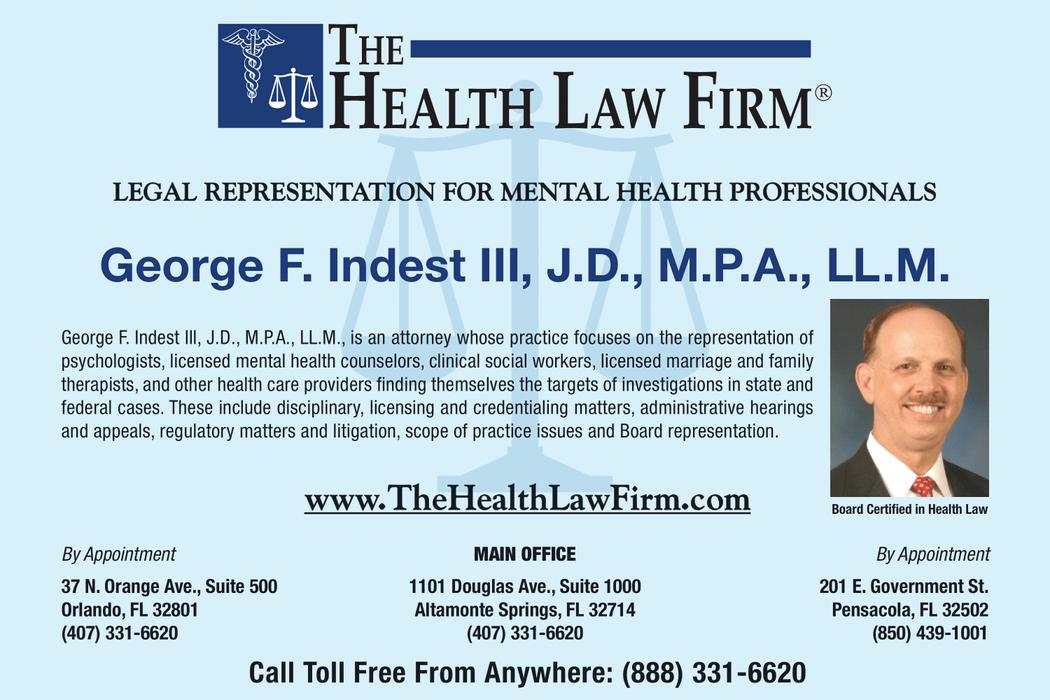


Professional Resource Article
Understanding how people make career decisions is rooted in career theories and is an essential step for counselors-intraining (CIT) to establish a knowledge base of the career counseling process (Osborn, 2009).The study of theories can oftentimes be dry and lead to boredom and, for counselor educators, finding a way to bridge theory with practice can be challenging According to Oberman and Studer (2009), “the use of creative strategies facilitates students’ learning and further comprehension of career development” (p 1) CIT’s may develop a greater appreciation for the influence that career philosophies have through a counselor educator’s ability to formulate exceptional collaborative strategies that are relevant and pertinent to counseling theories (Oberman & Studer, 2009). If the CIT can connect with the material on a personal and professional level, the more meaningful the theories become, and increases the likelihood to utilize this learning in their future practice. This article explores some best practices counselor educators may use when teaching career theory to CIT’s.
Oberman and Studer (2009) created a collaborative teaching strategy known as the theory collage. This activity would take up to 60 minutes to complete the assignment. Students are
randomly placed into small groups that are each assigned a specific career counseling theory, then directed to create a collage that represents the concepts of their assigned theory. The trainees may use available classroom resources to research their career theory and are required to include no more than ten pictures that would best describe the key strategies of their assigned career counseling theory The students would then create a brief slide presentation, carefully arranging the photos that concisely summarize the assigned career counseling theory Upon completion of the task, the collages would be posted to the class website with each group presenting their assigned theory to the rest of the students (Oberman and Studer, 2009) This in-class assignment allows students to work together in groups of two or three to formulate a visual understanding of career theories. The Theory Collage is an interactive method that would result in a brief overview of the key concepts of each of the theories and provides a sense of ownership to the students who illustrated them. This type of method may appeal to various learning styles.
Common core curricular areas such as career counseling that require some explanation of the subject, however profit from application-based activity and practice in the classroom, are the
best choices for a flipped class design When learning about career theory, Merlin (2016) proports that the flipped class design helps to avoid student negative expectations such as dry content material and boredom, and instead affords learners increased class time for activities and discussion while enhancing student engagement. Career Theory subject matter can be taught to learners via pre-recorded video lectures while still meeting CACREP National Standards (2016). Merlin (2016) created an outline that demonstrates the relevant standards that can be presented via a flipped class design (p.19). as illustrated in the Table 1.
Considering that the medium for instruction in higher learning institutions continues to advance towards distance, blended, and online learning formats, with limited live classroom time (and more so since the onset of the COVID-19 Pandemic), the flipped classroom design may be a valuable tool for counselor educators to maximize the time allotted for experiential classroom exercises.
“Savickas (2002) in the spirit of Julian Jaynes, asserted that the history of vocational psychology and vocational psychology itself are inseparable” (Briddick & Sensoy-Briddick, 2009, p. 36). Role plays are a tried-and-true method of engaging students in the learning process and is an effective way of connecting theory with process. One creative method of role playing that is simple to accommodate in career counseling courses begins with formulating smaller groups of students
AreaCACREPNationalStandards(2016)addressed inprerecordedvideolecture
*Theoriesandmodelsofcareerdevelopment, counseling,anddecisionmaking
*Processesforidentifyingandusingcareer,avocational, educational,occupational,andlabormarketinformation resources,technology,andinformationsystems
*Strategiesforassessingabilities,interests,values, personality,andotherfactorsthatcontributetocareer development
Note:AdaptedfromMerlin,C.c.(2016).Flippingthe CounselingClassroomtoEnhanceApplication-Based LearningActivities.JournalofCounselorPreparation &Supervision,8(3),44-71.doi:10.7729/83.1127
with each team member selecting a notable individual associated with a career theory A brief position paper is written by each team member on their assigned individual and then the group works together in creating a play, scene, or debate involving all the prominent persons they selected. (Briddick & Sensoy-Briddick, 2009, p. 38) Whatever method the teams select to present their findings, it will be interesting enough to capture the attention of the counseling students, while developing an enhanced comprehension of our career counseling forefathers and their schools of thought.
This article explored a few best practices that counselor educators may use when teaching career theory to counseling students Although the best practices examples noted here are limited, they do demonstrate that implementing some creativity into the classroom can be a positive experience for learning even the drier course contents. For future counselor educators, finding meaningful ways to personally connect career counseling theories with the process of counseling can serve to assist in the development of the practical skills needed to guide counselors-in-training and can also serve as a valuable tool to assist clients.
References
Briddick, W. C., & Sensoy-Briddick, H. (2009). Dabbling toward our future's
Past: Teaching the history of career counseling. Career Planning and Adult Development Journal, 25(1), 36-45. Retrieved from https://login.libproxy.edmc.edu/login?
Homework:*Watch20minutepre-recordedvideolecture
*Readbookchaptersaboutcareerresourcesandcareer assessments
Classroom:*Questionandansweraboutthevideolecture andreadings(15minutes)
*Practiceadministeringcareercounselingassessments withpartners(45minutes)
*Explorationofcareercounselingresourcesand applicationtocasestudy(45minutes)
*Roleplayingwithpartnersapplyingcareercounseling theory(30minutes
https://login libproxy edmc edu/login?
url=http://search proquest com libproxy edmc edu/docview/20 4144088?accountid=34899
Merlin, C. (2016). Flipping the counseling classroom to enhance application-based learning activities. The Journal of Counselor Preparation and Supervision. https://doi.org/10.7729/83.1127
Oberman, A H , & Studer, J R (2009, March) Strategies for effectively teaching career counseling. Paper-based on a program presented at the American Counseling Association Annual Conference and Exposition, Charlotte, NC. Retrieved from https://www.counseling.org/Resources/Library/VISTAS/2009V-pt.2/Oberman-Studer.pdf
Osborn, D S (2009) Teaching career theories, career assessments, and care information Career Planning and Adult Development Journal, 25(1), 46- 57 Retrieved from https://login libproxy edmc edu/login? url=http://search.proquest.com.libproxy.edmc. edu/
docview/204094838?accountid=34899
Written By: Maria Giuliana, LMHC, BC-TH Veteran
Maria (she/her) is a Board Certified Tel Health Provider, and Certified Wellbein With licenses in both Florida and Iowa, background, having served as a 20-year the founder of Beyond The Matter Coun Services LLC, Maria provides virtual cou Florida and Iowa Her dedication to mental health extends beyond her practice, as she actively serves as a board member and Military Services Committee Chair at FMHCA Specializing in supporting Military Veterans and their families, as well as addressing the unique concerns of the LGBTQIA+ community, Maria creates an inclusive and safe space for all As an Innate Wellbeing Specialist, Maria adopts a holistic approach that fosters lasting changes and empowers individuals to achieve and maintain emotional well-being beyond their sessions


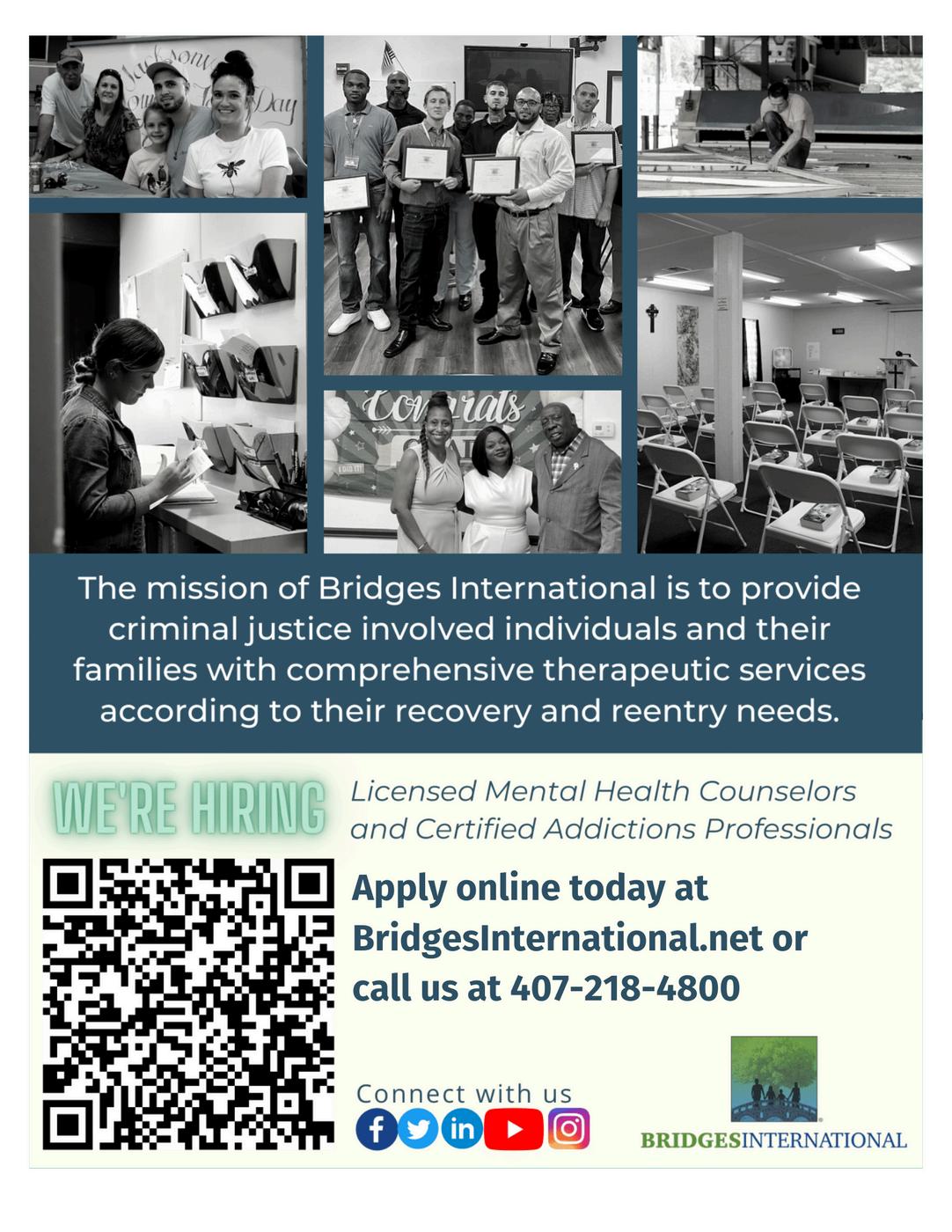
Provided by Committee Chairs
Get Involved! View all of FMHCA’s Committees here
Peddie-Bravo, LMHC, NCC
Greetings! We would love to see you at our committee as it is meant to serve as a place where graduate students and interns can meet and get all questions answered with support from licensed professionals in the field! It's a great place to network, ask questions, or simply just meet with and relate to people who are going through the same stage in their career as you are right now! Additionally, this is a great way to start getting involved with professional organizations and contributing to the field without absolutely no pressure! We hope to see you there!
The Graduate Student and Registered Mental Health Counselor Intern Committee is excited for the annual FMHCA conference which will take place January 29th, 2025 (Pre-conference workshops), and Thursday, January 30th through Saturday February 1st, 2025.You will notice that FMHCA has added a third day to the conference! Our committee is thrilled to be meeting in-person at the FMHCA conference! Our in-person event will take place Thursday, January 30th 6:30 pm – 7:30 pm in the Hibiscus Room (located at the Orlando Lake Mary Marriott, 1501 International Parkway, Lake Mary, FL 32746.) During the conference, you will want to make sure to visit the annual Student Poster Showcase!
Students and Interns often ask in our committee meetings “I don’t need continuing education credits yet, should I attend the conference?” Our answer is an enthusiastic “Yes!” There is much to be gained for Students and Interns attending the FMHCA conference! Just a few examples are networking with your colleagues, deep dives into topics outside Graduate education, and obtaining resources. While you may not need an internship site or supervisor right now, you will soon, and it’s a great opportunity to meet and network with those that can help you along your journey. The educational sessions are terrific opportunities to learn more than what is typically offered in a graduate school education There will also be tables set up throughout the conference site with multiple programs and tools which are helpful resources to learn about Plus, the energy at the conference is fantastic and will energize everyone about our chosen field of Mental Health Counseling! Our inperson mixer will be our first meeting next year If you’d like to
join our committee, the way to do that is by becoming a member of FMHCA if you aren’t already, and the committee is free to FMHCA members. Simply contact the office at: 561-2286129 or Office@FLMHCA.org Lastly, just like in your classes, there are no “bad” questions We would very much like to hear from you and answer any questions you may have about the committee or the conference
May each of you enjoy wonderful holidays and a happy new year and we will look forward to seeing you on 1-30-24 at our in-person event!
Government Relations Committee Committee Chair: Aaron Norton, PhD, LMHC, LMFT
FMHCA’s Government Relations Committee (GRC) is encouraging all FMHCA members to contact their legislators and schedule a meeting to introduce themselves and make legislators aware of FMHCA as a resource for mental healthrelated issues. To learn how to meet with a legislator for an introduction, click here to watch a 1-hour training video.
What else has the GRC been working on?
The GRC Chair addressed the 491 Board during it’s meeting on 12/4 in Tampa to read FMHCA’s recommendation to create a rule for 491 Board licensees that is similar to a rule for psychologists about the release of testing materials, answered questions from board members and legal counsel, and offered follow-up information about fair and equal access to tests.
The GRC and FMHCA’s lobbyist are securing commitment form two legislators to file a bill that would rename “registered mental health counselor interns” as “registered associate mental health counselors” and redact a statute that requires registered interns in private practice settings to have a licensed mental health professional “on the premises” when providing clinical services
A GRC subcommittee is exploring potential action related to adding counselors to a list of professionals who can offer ESE evaluations for the schools.
A GRC subcommittee is exploring potential action related to recommending that Florida’s Division of Vocational Rehabilitation revise a policy that prohibits it’s employees from using a diagnosis provided by a LMHC, LCSW, or LMFT who is not supervised by a psychologist or physician.

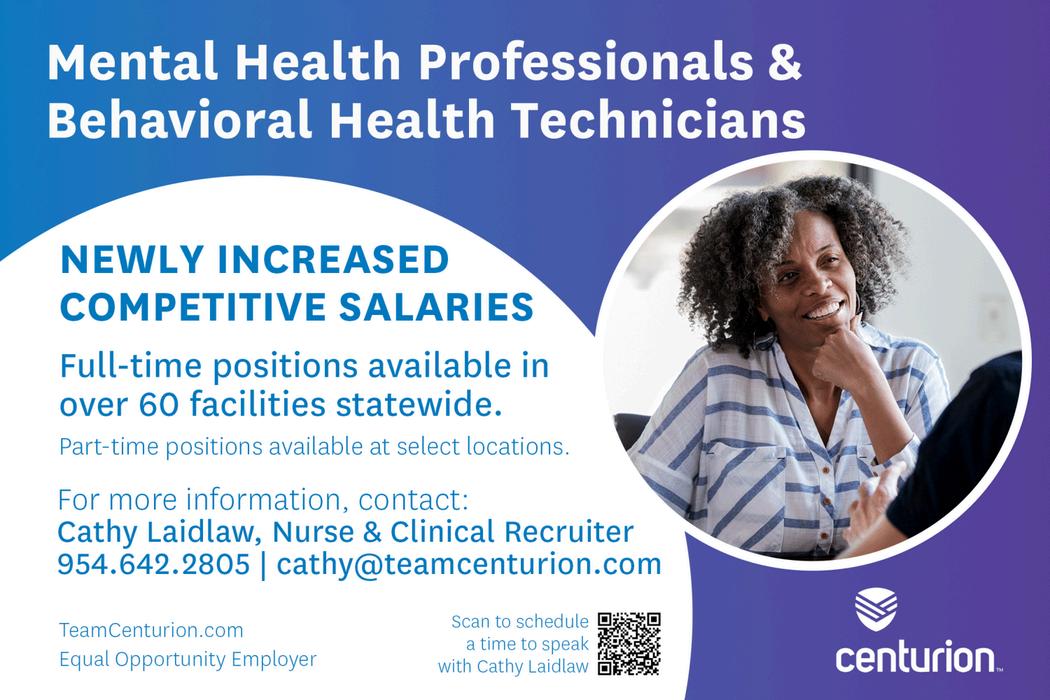

In the ever-evolving landscape of mental health treatment, therapists continually seek innovative methods to enhance their practice and provide comprehensive care for their clients. As an eating disorder therapist, I’ve witnessed firsthand the profound challenges individuals face in their journey toward recovery Diversifying my practice by incorporating consultation services has been a transformative step, allowing me to expand my reach and improve the quality of care This article explores my approach to integrating consultation services into my practice, the benefits it brings to both clients and myself, and strategies for fellow therapists considering this pathway.
Before delving into the benefits of consultation services, it is crucial to understand the complexity of eating disorders These conditions, which include anorexia nervosa, bulimia nervosa, binge eating disorder, and others, are characterized by severe disturbances in eating behaviors, body image, and weight regulation. They can stem from a combination of genetic, psychological, sociocultural, and environmental factors, making treatment multifaceted.
As therapists, we recognize that effective treatment requires a holistic approach, addressing both the psychological and physical aspects of these disorders Traditionally, therapy for eating disorders has relied on individual or group therapy settings. However, the demand for more diversified services is growing, and consultation is emerging as a powerful tool.
Consultation services involve providing expert advice and guidance in specific areas of expertise. In the context of eating disorders, this may include working alongside dietitians, medical professionals, and even family members of clients. By facilitating communication and collaboration among various stakeholders, consultation services can enhance the treatment experience for clients.
One of the most significant advantages of incorporating consultation services is the opportunity to collaborate with other healthcare professionals This collaboration allows us to create a comprehensive treatment plan that addresses the multifaceted nature of eating disorders. For instance, working closely with registered dietitians can ensure that clients receive appropriate nutritional guidance alongside their psychological treatment. This collaboration can enhance the therapeutic relationship and provide a more robust support system for clients.
By offering consultation services, I can tailor interventions that address the unique needs of each client. For example, some clients may benefit from a multidisciplinary team approach, where they receive both psychological therapy and nutritional counseling. Others may require family consultations to address dynamics contributing to their eating disorder. This flexibility in treatment strategies allows for a more personalized approach, increasing the likelihood of positive outcomes.
Consultation services can connect clients with additional resources that may benefit their recovery. This includes referrals to support groups, workshops, and other therapeutic modalities that complement traditional therapy. By acting as a bridge between clients and these resources, I can empower them to take an active role in their recovery journey
The risk of relapse is a significant concern in eating disorder
treatment Incorporating consultation services allows for ongoing support and monitoring, reducing the likelihood of relapse post-treatment Regular check-ins and communication with a multidisciplinary team can help identify early warning signs and address them proactively, further supporting sustained recovery.
Many clients and their families may lack understanding regarding eating disorders, which can hinder recovery. Through consultation services, I have the opportunity to provide educational resources that foster a deeper understanding of these complex conditions. This education can empower clients and their families, helping them navigate the recovery process with knowledge and confidence.
Consultation services enable clients to establish a broader support network. By involving family members, friends, and other healthcare professionals in the treatment process, clients can receive a more robust support system. This network can be invaluable during challenging times and can facilitate open communication about recovery goals and challenges.
Reach out to other healthcare professionals in your community who specialize in eating disorders Building relationships with registered dietitians, medical doctors, and other therapists can create opportunities for collaboration. Networking through professional organizations or attending workshops can also help you connect with potential partners.
Establish clear guidelines for your consultation services. This may include setting objectives for each consultation, defining roles and responsibilities, and determining effective communication strategies. Having structured protocols ensures that all parties involved understand the goals and expectations, facilitating a smoother process.
Communicate the benefits of consultation services to your clients. Help them understand how the collaboration with other providers aids in their individualized treatment as well as other clients in general.
Finding my passion for consultation has truly been one of the more rewarding attributes of my career development as well as my ability to spread awareness and education that will continue perpetuating clinical care in our field.


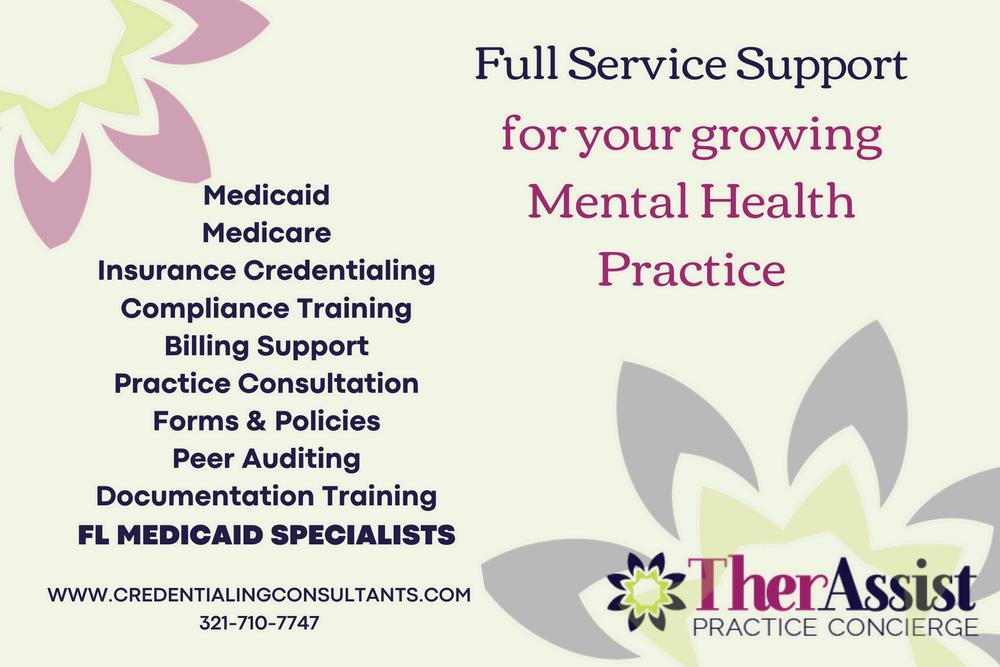




I am a therapist in private practice for over twenty years. I am also a survivor of Family of Origin Abuse. As I encourage my clients to do when facing a life altering event, I gave my life a deep dive audit. The outcome was a philosophy and a business plan proven beneficial for the survivors of family of origin abuse I’ve worked with in my practice.
Like my clients who grew up immersed in chaos and fear, I spent much of my life looking for "home". Home was contingent on a parental- like approval from practically whomever I was interacting with, regardless of age or circumstance. These designated others became like casting directors who could deem survivors for the role of “home-worthy” For many survivors of early child abuse, every situation can be like a new audition with new casting directors to say yay or nay to their level of worth, intellect and presentation
In my deep dive, I factored in the dynamic of an Identified Patient dealing with abusive relatives, where the IP comes away
from the interaction feeling like tangible property. Right then, in mid dive it hit me. What so many survivors were giving away to others was custody of self. Because of the patterned frequency of giving others custody of self, Freud’s Repetition Compulsion fit the aspect of striving for a pseudo “second chance” to correct the damage. But exactly what was repeatedly given away became clear. An image of me struggling to respond to a bitchy comment at a party reminded me of the feelings that preempted handing my custody of self over to a “superior” Holding this image and challenging my then beliefs helped me recognize that I was my full custodian – on a logical level I didn’t feel like it often, especially when in either abusive environments or modestly mean situations The goal was to learn what being a full, consistent self-custodian looked like and felt like by practicing acting -as if- I was my full custodian regardless of approval and no matter how frightening the potential rejection of another person felt. In alignment with Dr. Albert Ellis and his REBT, Custody of Self is a philosophy ideal for use as “D” to dispute negative beliefs within the ABC’s of
REBT The specifics of practicing, eye contact, posture, lower, slower speech pitch, direct language emanated from holding Custody of Self as a POV worth working towards, even in a start comprised of tiny moments. Beyond individuation that was linked to specific interests and traits, I needed and was entitled to custody of myself and that also meant custody of my small business.
An adult survivor of child abuse is automatically not only a survivor, but also a business owner. The mission is basic survival and the vision is a life that includes home, hearth, love and purpose. Every successful business needs a president. My clients respond positively to validation from pairing of Custody of Self with conceptualizing their lives as a small business. In alignment with Maslow, the client’s foundation for practical survival- (business) is the starting point for therapy. After the initial intake and the getting acquainted phase of therapy has passed, is the Assembly Line Approach. The assembly line approach begins with creating a timeline On this timeline, actions that sabotage security and happiness and actions that promote security and happiness are mapped out and linked up with the time, day and circumstances when they occur Typically, behaviors don’t happen within a vacuum When a behavior is repeated, there are similarities shared by the various circumstances in which the behavior occurs and predictable thought patterns and beliefs that make up the survivor’s response. By constructing the assembly line and dissecting it within sessions, we incorporate strategic and tactical business development skills as a psychological modality. During this phase of therapy, our emphasis is on the structure of a client’s life in terms of daily schedules, finance, associations and actions/interactions with others. Emotions are tracked showing day, time, circumstances to mark where they fit on the assembly line. Goals are established that include internal goals, such as implementing new beliefs and external goals where the client’s ideal actions are targeted as desired outcomes
Sometimes not working on trauma is working on trauma, and sometimes working on trauma when there is no stable baseline level of housing, employment, social support and schedule is retraumatizing It is understandable for the client and therapist, both eager to get to the core issues of the presenting problem, to delve into the deeper emotional issues and past traumatic events without first determining the level of security in the mechanics of the client’s lifestyle. When skipping over the trivial, daily life challenges, even when effective therapy took place, the client becomes more vulnerable to the difficult
situations in the present The energy delving into the mud and muck of therapy is continuously expended as processing takes place in-between appointments The day-to-day challenges seem insignificant and even a distraction from the client’s memories and complex life events. The risky result is that the client experiences more events that feel too emotional taxing to participate in from a position of strength. Jung’s quote, “If all you have is a hammer, everything looks like a nail” is proven. By validating the merit and meaning of a client’s daily life, the client gets a strong ability to distinguish his life from the “nails” being discussed in therapy. Routine situations are handled. The client gets familiar with mastery over his immediate environment.
David’s mother, Terri, was the social butterfly of New Jersey. Always the best dressed, the most up to date about on goings of the neighborhood’s rich and famous, Terri made a name for herself beginning in the fall of 1966 at their anniversary party when she and Ed and moved away from their suburban home to Queens just in time for her to give birth to David House parties where like a third roommate Ed’s hours were never ending He loved being a firefighter Though not a fan of his wife’s steady stream of friends at the house, he liked being able to get drunk at will with everyone being preoccupied, intoxicated or both. David described his childhood as a hijacking, recounting being dropped off at his cousin’s whenever the party and his dad’s absence were paramount – which was weekly. He remembered many times when he was told to pack preemptively as his home would not be available.
David’s family included the entire fire department of NY state as his father earned a reputation as the best instructor His oldest uncle was a fire chief His father provided trainings throughout the northeast region His mother was credited for writing the most comprehensive training workbook for firefighters She met David’s father while conducting an interview with him after auditing his classes for a full month. Both of his parents were first generation American, both born and raised in large apartments in Bay Ridge that housed parents, grandparents, siblings, aunts, uncles and cousins, and, both families were plagued my alcoholism. The pattern continued within the couple’s home and watered down the childhoods of their two children. David and his sister, Lilly looked like miniature adults, worn from pulling all-nighters listening to their parents party and fight.
David began drinking by sipping the left-over alcohol in the glasses left throughout the house or in the kitchen sink. As a preteen, it was always easy to take shots from any of the
collection of bottles left out on display in the dining room China closet By high school and throughout college, David liked to go to school with a flask in his backpack Though his evenings and weekends were filled with fights and blackouts, David graduated in the top five percent of his class with a doctorate in mechanical engineering.
David’s alcoholism lead to one final arrest for disorderly conduct that he had to face from a hospital bed That same week, when his on again off again girlfriend became pregnant, David proposed before making a vow that his baby would never see him drunk and as long as he was a father, he would ever drink again His baby boy marked the break and final end of the family cycle His son his now sixteen and David is almost seventeen years sober.
By the time David began therapy with me, he was already aware that he was the Hero Child in terms of his assigned role within his family. David prided himself on thorough research about the roles children play in alcoholic families, and his personality style of self-reliance and resiliency He told me all this in his first sentence following my “hello” It was Sunday and I typically did not answer my work phone, but there it was ringing next to my personal cell and for some reason, I felt an internal directive to pick up
Then David’s voice took on a confidential tone, more like that of a whistle blower revealing secrets to a reporter in a recorder phone call.
“I am so angry right now, it’s burning through my veins I could spit venom ”
David’s wife, a celebrity chef and restaurateur was photographed in an intimate kiss with one of her investors. With photo in hand and propelled with pure adrenalin, David questioned everyone who had access to his wife’s whereabouts. The affair kept getting closer to David’s own personal life, to the point where the cleaning lady revealed knowledge of his wife having the same man over
David was asked to leave the house upon confronting his wife. He admitted to throwing a vase from their engagement party, but denied any threats.
“I watched the vase shatter in front of the wall, picked up my gym bag and went into the spare bedroom Next thing I know my wife is suddenly disheveled with tears and mascara down her face and a cop is telling me to leave ”
David spent that night in a hotel room. He said his entire life felt like a robbery where he was the victim. He became aware of the theft three nights ago when it was raining. His tires were low. His car reeked new car plastic. It was this stupid new loaner toy
car he drove that seemed to be only inching towards his house Amanda was there Good He was happy to see his wife He turned down their street, pulled up into the driveway Amanda tensed as the unfamiliar car pulled into the driveway past their son’s big wheel and seemed to yell. A man walked out. Out of his house. There, right out of his own front door walked -Him. This guy he saw before. A month before. At the restaurant. Trillo’s was always their go to place when they wanted a calm, quiet atmosphere and Italian food. “Who’s that?” He had asked. And like so many other times asking so many other questions, he got no answer, only Amanda’s blank stare. Why did that preoccupied look of hers always suffice as an answer? Why did he almost always let her off the hook? He wasn’t sure whether he hated her for her dismissive games more than himself for accepting them What he did know is that he felt at war with his entire life The lynchpin had been pulled Nothing could be put back neatly in its delusional band-aid place By the time the police left, Amanda and her friend drove away and he was to remain in the house that night with their son This would be his last night in the house and he was to coordinate with Amanda to eventually get his things. They would divorce. It was now in play.
“Tire tracks in the dirt road make the next truck get through faster.” My best go- to metaphor for past abuse paving the way for future abuse
David started crying. A silent cry, with his face beat red and his hands covering most of it. He took my metaphor without my adding about his marriage being the next truck and his family of origin sounding like the definite first.
“Why does it always come back? Why does it always come down to them?” He leaned in further
“I don’t want to scare you, but I feel like I could kill. She knew my family life and promised me we’d always be a team.” We were midsession and a pattern of constantly caretaking for others at his own expense emerging. The resulting damage was compounded by the deeper awareness that he was harmed by his family, by the very people he worked so hard to win over.
Soon David saw that regardless of the topic being about the years of cleaning up the totality of his father’s mess from all the black outs all the nights before or about how right from the start of his marriage, he was charged with putting on a performance worthy united front for his wife’s family, his rights were almost always deemed nonexistent. David made the new decision that a life without rights was not livable. The assembly line structured the process of teasing out the specifics of exactly what transpired within his relationships. Moments where his rights were annihilated in past events were now blinking lights
of neon transparency We looked at the nonverbal, unwritten contracts that he participated in, the reasons behind his choices, and the toll taken Session time was spent delving into the toll taken and looking at the rewards/consequences lead to the final step of David’s declaration of “no more”. The rewards of connection were not worth the consequences of abuse. He was creating new standards that would be binding and nonnegotiable.
Written By: Pamela Garber, LMHC
Pamela brings over 20 years of p experience, counseling individua families facing depression, anxie related challenges She provides to organizations after incidents collaborates with management t


REGISTER HERE!
REGISTER HERE!
